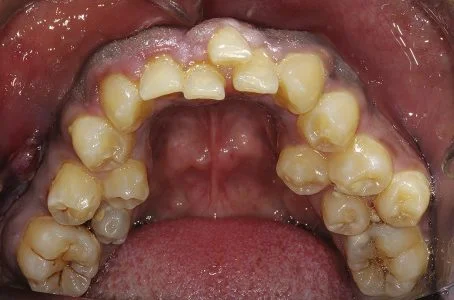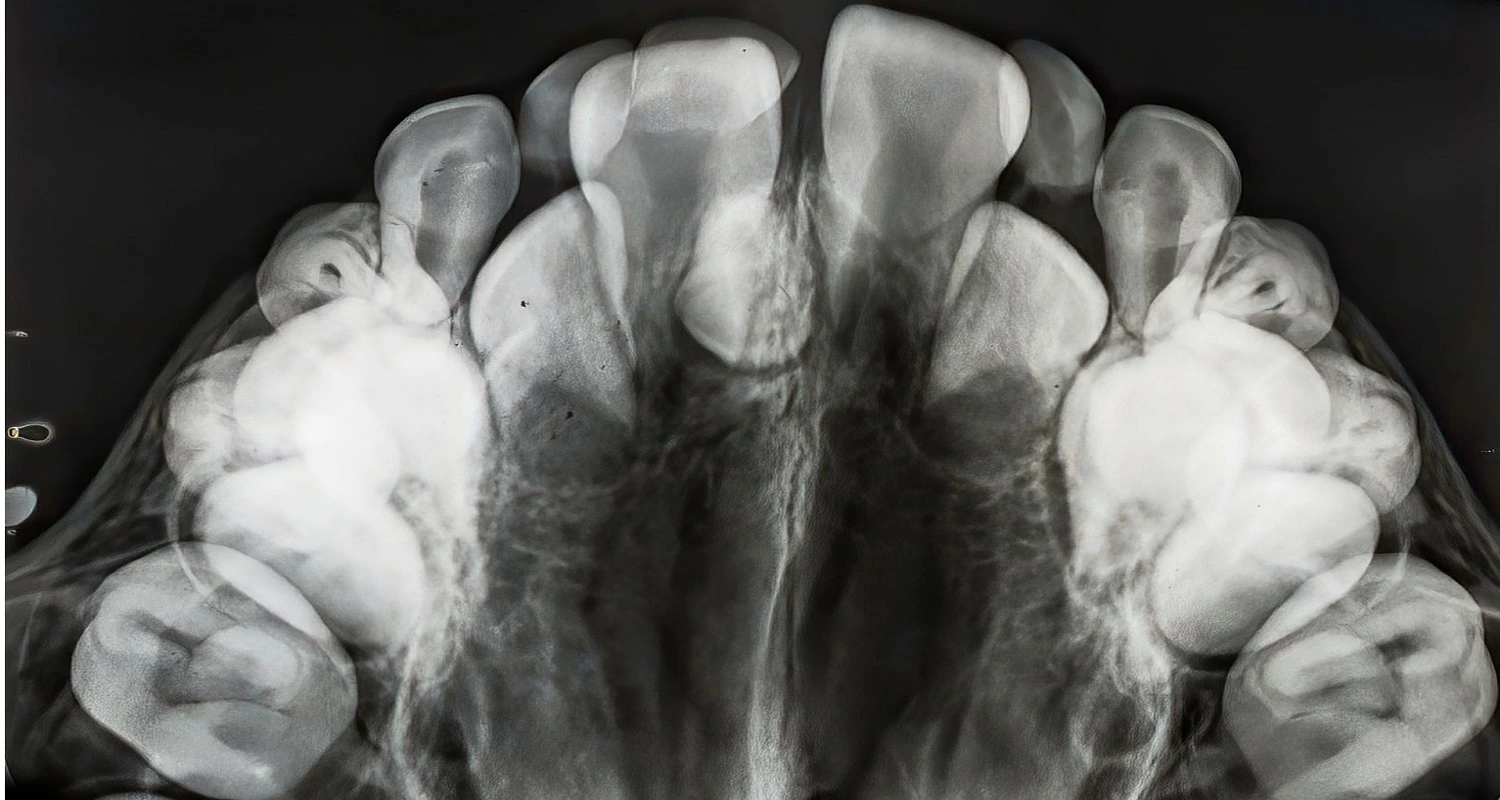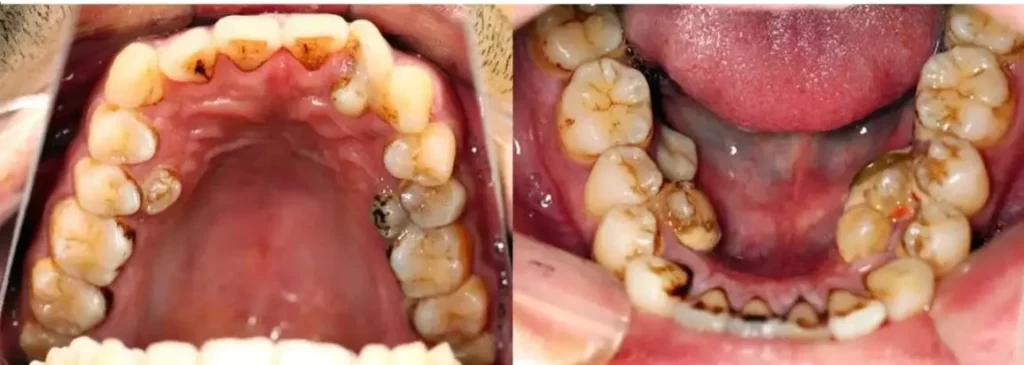Last Updated on: 19th September 2025, 12:52 pm
Hyperdontia is a disorder in the growth of extra teeth. In this article, you will learn its classifications, causes, and treatments.
In general, human beings have two types of dentition. The first occurs in children between 6 months and 6 years approximately. This dentition is temporary and replaced by permanent teeth.
Adult dentition begins at age 6 with the appearance of the first permanent tooth, which is generally the lower central incisor. The permanent dentition is completed at approximately 12 or 14 years of age and, as its name indicates, it is the final dentition, the one that accompanies the person for the rest of life.
The number of teeth also varies depending on whether it is an adult or a child.
In the temporary dentition, the number of teeth is 20: 2 central incisors, 2 lateral incisors, 2 canines, and 2 molars. On the other hand, for permanent dentition people have 2 central incisors, 2 laterals, 2 canines, 4 premolars, and 4 molars.
However, the number of teeth can vary and more or fewer teeth can be present than normal. If you have fewer teeth, it is called anodontia, but if you have more teeth, it is called hyperdontia, although some professionals may call it supernumerary.
What is Hyperdontia or Supernumerary Teeth
Hyperdontia, a dental anomaly, refers to the presence of supernumerary teeth beyond the regular dental count. This condition arises due to irregular dental development, resulting in extra teeth that can vary in size and form. These additional teeth can lead to complications like misalignment and overcrowding, potentially impacting oral health. Genetic factors, environmental influences, and certain syndromes contribute to its occurrence.
Diagnosis involves dental examinations and imaging, while treatment ranges from observation to orthodontic intervention or tooth extraction, depending on severity. Understanding hyperdontia is crucial for effective dental management and maintenance of oral well-being. The condition affects approximately 1 to 4 percent of the world’s population.
Classifications of Hyperdontia
Supernumerary teeth can erupt anywhere in the mouth; however, finding them in the dental arch is more common. According to their location, they are classified as:
1. Mesiodens: a tooth that forms between the central incisors
2. Distomolar: teeth that grow behind the molars
3. Paramolar: a tooth grows alongside the molars outside of the dental arches
4. Natal tooth: teeth that present at birth or shortly after birth. The most common are mesiodens.
The supernumeraries can also be classified according to shape:
1. Supplementary: The shape of this tooth is the same or similar to the teeth that surround it.
2. Conical: They are usually wide at the base and narrow at the tip. are very similar to canines and have a root. Of note, this type of tooth is the most common.
3. Tuberculate: The tooth is either barrel-shaped or tube-shaped. They have normal roots and rarely erupt. This type of t00tth can delay the eruption of normal teeth.
4. Compound odontoma: This is a formation of different small teeth wrapped in a bag. These teeth do not erupt, but they can interfere with the eruption of normal teeth.
5. Complex odontoma: The tooth is formed from a tissue similar to normal teeth. They are irregular and there are usually several, not just one.
6. Molariform: The shape of this tooth is similar to premolars; they are fully rooted and usually erupt close to the molars.
If the redundant tooth or teeth are visible, they are classified as “erupted”; conversely, if the teeth are not visible, they are classified as “impacted”.
What Causes Hyperdontia?
Hyperdontia does not have an apparent cause; however, theories propose that the development of supernumerary teeth is due to the hyperactivity of the dental lamina cells, the precursors of tooth formation, although it can also be related to hereditary syndromes such as:
1. Cleft lip/palate
This is a condition characterized by a cleft or opening in the roof of the palate and upper lip.
2. Gardner syndrome
A genetic disorder that can cause the growth of the colon and skull and/or cysts on the skin.
3. Endocranial Dysplasia
A condition characterized by abnormal development of the clavicle and skull.
4. Faray’s disease
This syndrome presents with skin rashes, pain in the stomach, pain in the feet and hands, and inability to perspire.
5. Ehlers-Danlos Syndrome
This congenital condition causes loose joints, scoliosis, and pain in the joints and muscles.
6. Down syndrome
This condition is associated with growth retardation, very marked facial characteristics, and some intellectual disabilities.
7. Ellis van Creveld syndrome
This syndrome is characterized by dwarfism in the extremities fingers and toes, It is also associated with cardiac abnormalities.
8. Nance-Horan Syndrome
This syndrome involves the development of cataracts affecting long-term vision.
9. Rubinstein-Taybi syndrome
This syndrome is characterized by short stature, intellectual disability, and some facial features, as well as problems with the teeth, heart, and kidneys.
Trichorhinophalangeal syndrome: This syndrome leads to bone and joint malformations, abnormalities of hair, teeth, and skin, as well as characteristic facial features.
Hyperdontia Symptoms
Supernumerary teeth can develop singly or in multiples on both sides of the jaw and on both upper and lower dental arches. Supernumerary teeth are asymptomatic, that is, they do not generate any type of discomfort or pain.
One of the most common characteristics is the shape of the teeth, they can be very similar to normal teeth, although the vast majority of supernumerary teeth have an atypical conical shape.
These teeth can cause problems or diseases in the mouth such as crowding of the teeth and caries (due to the accumulation of plaque due to dental malposition caused by the supernumerary tooth). They can prevent the normal eruption of the teeth or in the worst case with complex or compound odontomas, they can make the roots of the teeth erupt.
In addition to the above complications, the following may also occur:
• Delayed eruption
• Crowding of the teeth present in the mouth
• Development of cysts and tumors
• Fusion with other erupted teeth
• Difficulty eating or chewing
• Problems performing optimal dental hygiene
• Gum disease
• Displacement of teeth
How to Diagnose Hyperdontia?
If the teeth are visible, diagnosis is very easy based on what the dentist sees with the naked eye. For unerupted teeth, the diagnosis is made using X-rays, preferably panoramic X-rays.
In some cases, other types of diagnostic means such as computerized axial tomography can be used. (CT)
Hyperdontia Treatments
In some cases, hyperdontia does not need treatment, although in most cases, it is suggested to be done.
The most common treatment is extraction or removal of the tooth; however, extraction is also recommended when you
1. Have a genetic condition that predisposes the appearance of more teeth
2. Have a genetic condition
3. Cannot chew properly.
4. Feel pain or discomfort in the case of dental crowding
5. Have difficulty performing adequate oral hygiene
6. Feel uncomfortable or self-conscious about the way your extra teeth look.
7. Think affects your aesthetics
Extraction of supernumerary teeth, which is the same as tooth extraction, is performed under local or general anesthesia depending upon the location and development of the extra tooth. The age to perform the extraction of supernumerary teeth is also relative. It is preferred to be done as an adult; however, it must be evaluated how much it could affect neighboring teeth and structures.
To discover advice on expediting the healing process following a tooth extraction, click here.
Frequently Asked Questions
How Many Teeth Are Present in People with Hyperdontia?
Individuals with hyperdontia have more than the typical number of teeth. This condition is defined by having over 20 deciduous (primary) teeth or more than 32 permanent teeth. Studies suggest that hyperdontia affects between 1% and 4% of the population, with males being twice as likely to have this condition compared to females.
What Does an Excess Amount of Teeth Mean?
Hyperdontia is a dental condition characterized by the growth of an excessive number of teeth. These additional teeth, often referred to as supernumerary teeth, can appear in any part of the dental arches—the curved areas where the teeth are attached to the jaw.
What Is the Maximum Number of Teeth an Adult Can Have?
An adult typically has a full set of 32 teeth, including the wisdom teeth located at the back of the mouth. However, not everyone develops wisdom teeth. These teeth usually emerge later in life, typically between the ages of 17 and 21.
Can Braces Correct Hyperdontia?
Yes, braces can often be used to treat hyperdontia. The main approach to managing hyperdontia involves surgical intervention to remove the extra teeth. This is typically followed by orthodontic treatments such as braces, Brius, or Invisalign® to properly align the teeth and jaw.
Is Surgery Required for Hyperdontia?
Surgery may be necessary for hyperdontia if the extra teeth, known as supernumerary teeth, are impacted and remain below the gumline. In such cases, surgical removal of these teeth is often required.
Share:
References
1. Cruz, E.-A. (March 27, 2014). Stomatology magazine. Retrieved from Supernumerary teeth classification: a literature review: https://bibliotecadigital.univalle.edu.co/server/api/core/bitstreams/8db3463e-e8b1-4a2b-b3c2-98d7707783c1/content
2. Cueto Blanco , PV (01 May 2013). Advances in odontostomatology. Retrieved from Prevalence of supernumerary teeth in the child population of Asturias: https://scielo.isciii.es/scielo.php?script=sci_arttext&pid=S0213-12852013000300003
3. Jennifer Archibald, JL (March 3, 2020). Medical News Today. Retrieved from Hyperdontia: definition, types and treatment: https://www.medicalnewstoday.com/articles/hyperdontia
4. M, B. (2019). Pathology of the teeth. In B. M, Color Atlas of Oral and Maxillofacial Diseases (pp. 41-78). South Carolina: Elseiver.
5. Marjory E. Vaca-Zapata, KA-R. (January 15, 2015). I dominate the sciences. Retrieved from Prevalence and location of supernumerary teeth: https://dominiodelasciencias.com/ojs/index.php/es/article/view/270
6. Murillo, MP (April 1, 2013). Mexican dental magazine. Obtained from Supernumerary teeth. Clinical case report: https://www.elsevier.es/es-revista-revista-odontologica-mexicana-90-articulo-dientes-supernumerarios-reporte-un-caso-S1870199X13720226
-
Nayibe Cubillos M. [Author]
Pharmaceutical Chemestry |Pharmaceutical Process Management | Pharmaceutical Care | Pharmaceutical Services Audit | Pharmaceutical Services Process Consulting | Content Project Manager | SEO Knowledge | Content Writer | Leadership | Scrum Master
View all posts
A healthcare writer with a solid background in pharmaceutical chemistry and a thorough understanding of Colombian regulatory processes and comprehensive sector management, she has significant experience coordinating and leading multidisciplina...

















